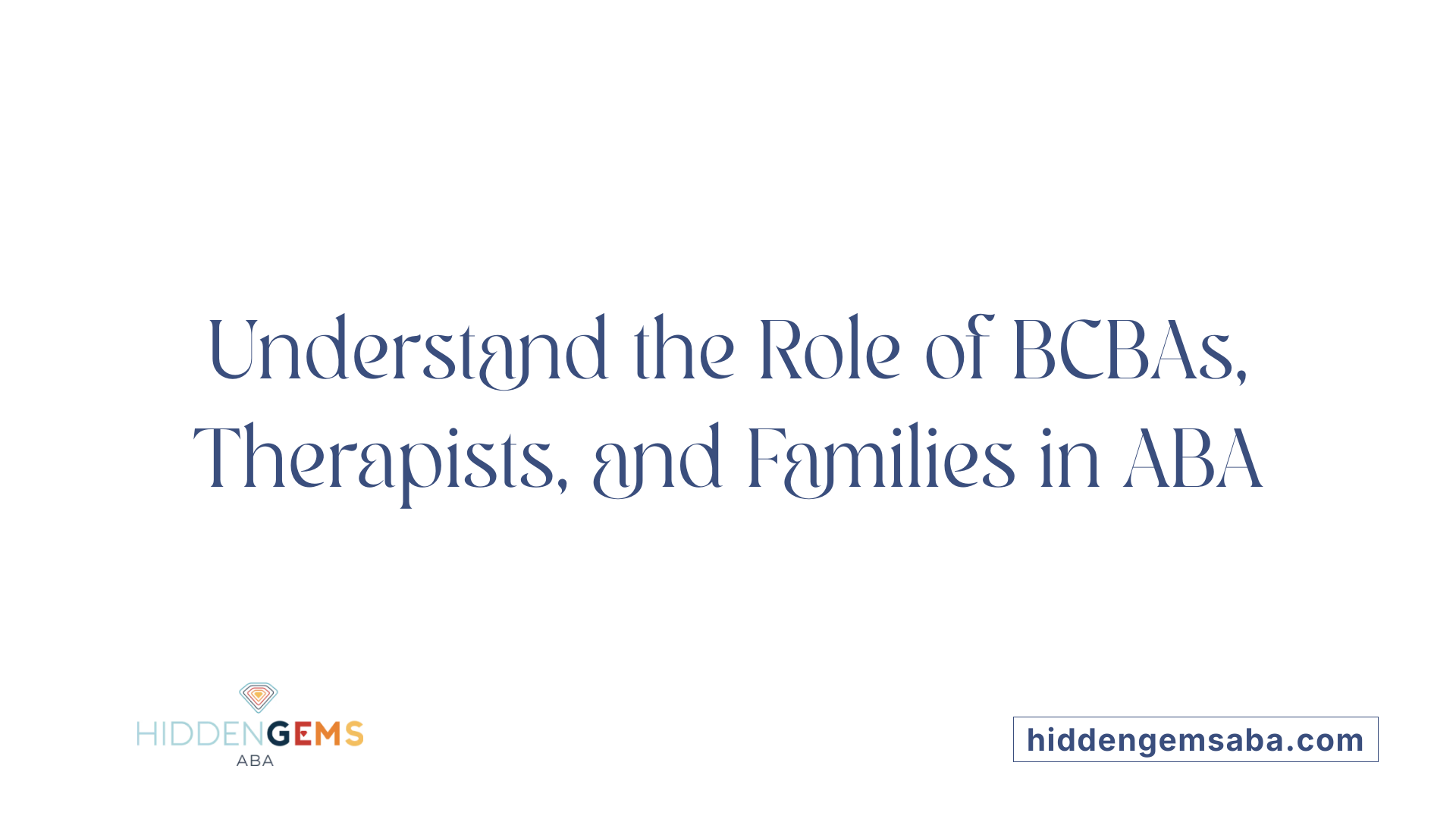Understanding ABA Therapy's Role in Behavioral and Emotional Growth
Applied Behavior Analysis (ABA) therapy stands as a cornerstone in autism intervention, systematically helping children develop vital life skills, including self-calming strategies. This article explores ABA therapy’s scientific foundation, its personalized approaches, and how it cultivates resilience and emotional regulation in children with autism by teaching them effective ways to manage their behaviors and emotions.
What is Applied Behavior Analysis (ABA) Therapy?
What is Applied Behavior Analysis (ABA) therapy?
Applied Behavior Analysis (ABA) therapy is a science-based intervention aimed at understanding and modifying human behavior by analyzing how behavior is influenced by the environment. Its primary goal is to increase helpful behaviors and reduce harmful or disruptive ones.
What science supports ABA therapy?
ABA is grounded in the science of learning and behavior. It examines the antecedents (what happens before a behavior), the behavior itself, and consequences—known as the ABCs of ABA—to effectively teach and change behaviors.
How is ABA individualized?
Each ABA program is personalized to fit the unique needs and abilities of the individual. Treatment goals focus on developing communication, social, self-care, play, motor, and academic skills. These plans are carefully designed and overseen by Board Certified Behavior Analysts (BCBAs).
What role do Board Certified Behavior Analysts (BCBAs) play?
BCBAs assess individuals’ strengths and challenges, set measurable goals, and monitor progress through data collection and regular reviews. They ensure therapy remains tailored and effective as the individual grows.
Which techniques are used in ABA therapy?
One of the primary techniques is positive reinforcement—rewarding desired behaviors to encourage their repetition. Other strategies include skill-building activities, gradual exposure to new experiences, and the use of visual supports and social stories.
Where is ABA therapy provided?
ABA therapy is flexible and can take place at home, school, or community settings. It may involve one-on-one or group instruction, depending on the individual’s needs.
Why is positive reinforcement important?
Positive reinforcement motivates individuals by rewarding desired behaviors, making it more likely those behaviors will be repeated and lead to meaningful change.
How is ABA therapy recognized?
ABA is widely regarded as an evidence-based best practice treatment by organizations such as the US Surgeon General and the American Psychological Association. Research has repeatedly demonstrated its significant benefits, especially for children with autism spectrum disorder.
Key Benefits of ABA Therapy for Children with Autism

How does ABA therapy benefit individuals with autism?
ABA therapy is designed to support children with autism by fostering skill development across various areas. It helps improve communication, social interaction, self-care, play, and academic abilities through personalized plans tailored to each child's unique needs. By applying techniques grounded in behavioral science, such as positive reinforcement, ABA therapy encourages helpful behaviors and reduces problem behaviors.
Skill Development and Behavior Modification
ABA programs promote the acquisition of essential life skills, including language, attention, memory, and motor skills. The therapy's consistent use of the ABCs (Antecedents, Behaviors, Consequences) allows therapists to understand behavior patterns and effectively teach new behaviors or modify existing ones. This systematic approach leads to meaningful improvements in everyday functioning.
Communication and Social Interaction Enhancement
Improvements in communication are a central benefit of ABA therapy. Teaching functional communication skills enables children to express their needs and emotions, which helps reduce frustration and behavioral challenges. Additionally, techniques like social stories, role-playing, and visual supports aid social skill development and help children adapt to changes, benefiting their social engagement.
Reduction of Problem Behaviors
ABA therapy uses data-driven strategies to identify triggers for challenging behaviors and develop tailored management plans. Positive reinforcement encourages flexibility and problem-solving abilities, reducing disruptive behaviors while promoting adaptive responses.
Importance of Early Intervention and Long-Term Impact
Early and intensive intervention with ABA harnesses brain plasticity, leading to better outcomes in language, socialization, and independence. Over time, ABA therapy supports improved self-care, academic success, and overall quality of life, empowering children to navigate their environments confidently.
By combining individualized treatment, behavioral analysis, and consistent parental involvement, ABA therapy has demonstrated significant benefits, making it a leading evidence-based approach for children with autism.
Who Provides ABA Therapy?

Who Provides ABA Therapy?
ABA therapy is provided primarily by Board Certified Behavior Analysts (BCBAs), who are highly trained professionals responsible for designing and overseeing individualized treatment plans. The BCBA assesses the child's needs, sets personalized goals, and continuously monitors progress through detailed data collection.
What Roles Do Therapists and Behavior Technicians Play?
Qualified therapists and behavior technicians work under the supervision of a BCBA to implement ABA interventions. They use scientifically supported techniques like positive reinforcement to encourage helpful behaviors and carefully observe antecedents and consequences to effectively support learning.
In Which Settings Is ABA Therapy Provided?
ABA therapy can take place in various environments including specialized clinics, community centers, schools, and homes. This flexibility allows therapy to be tailored to each child's unique environment and needs, promoting generalization of skills across settings.
How Important Is Family Collaboration?
Family involvement is integral to the success of ABA therapy. Providers collaborate closely with families, offer parent training sessions, and provide resources to support consistent strategy reinforcement at home. This partnership enhances the child’s progress and helps integrate therapy into daily life.
What Should Families Consider About Access and Insurance?
Accessing ABA therapy typically begins with a healthcare provider referral and an initial assessment. Insurance coverage varies widely; many private and Medicaid plans require documentation of medical necessity but do cover ABA services. Families are encouraged to verify benefits and locate qualified providers experienced with their insurance.
Table: ABA Therapy Providers Overview
| Provider Type | Role | Typical Setting(s) |
|---|---|---|
| Board Certified Behavior Analyst (BCBA) | Designs & supervises treatment plans | Clinics, homes, schools |
| Therapists & Behavior Technicians | Implement behavior interventions | Community centers, homes, schools |
| Family Members | Support consistent reinforcement | Home |
This collaborative network ensures ABA therapy is delivered effectively, tailored to each child’s needs, and accessible through a range of community and clinical settings.
The ABA Therapy Process: From Assessment to Skill Mastery
What is the typical process for ABA therapy?
The typical ABA therapy process starts with an initial comprehensive assessment performed by a board-certified behavior analyst (BCBA). This assessment evaluates the child's specific behaviors, communication abilities, social skills, and other developmental areas to create a detailed profile of needs and strengths.
Based on this evaluation, a personalized treatment plan is crafted. The plan sets individualized goals targeting areas such as language development, self-care, social interaction, and reduction of challenging behaviors. It is tailored to the child's unique needs and abilities.
Therapy sessions are delivered using evidence-based techniques. One common method is Discrete Trial Training (DTT), a structured approach breaking skills into small, teachable steps reinforced through repetition and positive feedback. Other strategies may include functional communication training and naturalistic teaching to build real-world skills.
Progress is continually tracked through careful data collection and regular assessments. This allows the BCBA and therapists to monitor advances, identify challenges, and make timely adjustments to the plan to optimize learning outcomes.
Family involvement plays a central role. Caregivers are trained in ABA strategies to support learning during daily routines at home and in various settings, enhancing consistency and skill generalization. Open communication between families and therapists ensures alignment of goals and reinforces behaviors across environments.
This dynamic, data-driven process supports children with autism in acquiring meaningful skills, gaining independence, and improving quality of life through systematic, individualized interventions.
Teaching Self-Calming Strategies Through ABA
Why Are Self-Regulation Skills Important in ABA?
Self-regulation skills help children with autism manage their emotions and behaviors, especially during stressful situations or changes. Developing these skills can reduce frustration and meltdowns, enabling children to respond more calmly and effectively.
What Coping and Calming Tools Does ABA Use?
ABA therapy incorporates practical coping tools such as sensory toys and breathing exercises. Sensory toys offer tactile or visual stimulation that can soothe and focus a child, while breathing exercises teach controlled breathing to reduce anxiety.
How Does Functional Communication Training Support Self-Calming?
Teaching children to express their feelings and needs through functional communication reduces frustration and helps them ask for support when overwhelmed. This skill fosters independence and emotional regulation.
What Role Does Positive Reinforcement Play in Self-Calming?
Positive reinforcement encourages children to use self-calming strategies by providing praise or rewards when they successfully apply these tools. This motivates repeated use and builds lasting habits.
How Are Structured Social Stories Used?
Structured social stories are short, clear narratives that prepare children for upcoming changes or stressful events. By outlining what will happen and how to cope, these stories reduce uncertainty and anxiety.
What Are Visual Schedules and How Do They Help?
Visual schedules display daily routines and upcoming activities to promote predictability. They help children know what to expect next, which supports smoother transitions and less distress.
How Do Role-Playing and Gradual Exposure Develop Self-Calming?
Role-playing lets children practice handling new or challenging situations in a safe setting, building confidence. Gradual exposure introduces small changes step-by-step, preventing overwhelm and teaching flexible coping.
By integrating these strategies into personalized ABA programs, therapists and parents work together to empower children to self-soothe and adapt, ultimately enhancing emotional well-being and social success.
Creating Predictable Environments to Ease Anxiety and Support Learning

Why are consistent schedules important in ABA therapy?
Consistent schedules provide a predictable environment that helps reduce anxiety in children with autism. When daily routines remain steady, children feel more secure, which increases their motivation to engage and learn. A stable schedule also helps reduce the frequency of challenging behaviors by minimizing unexpected events that may cause distress.
How do visual supports and routines aid learning?
Visual supports like schedules and cues offer clear, concrete information about what to expect throughout the day. These tools help children understand transitions and upcoming activities, which reduces uncertainty. By using predictable routines paired with visual cues, ABA therapists help children build confidence and mastery in navigating daily life.
What role do social stories play in reducing uncertainty?
Social stories are short, positive narratives that describe upcoming changes or new situations in an understandable way. They prepare children by setting clear expectations and modeling appropriate responses. By reducing fear of the unknown, social stories make transitions smoother and help children adapt more readily to change.
How does ABA therapy support generalization of social skills across settings?
ABA emphasizes teaching social skills like sharing and turn-taking through structured interventions such as discrete trial training. Through consistent practice in multiple environments, children learn to generalize these skills beyond therapy sessions, improving their ability to interact with peers and adults in everyday life.
What strategies help manage challenging behaviors?
Consistent therapy enables identification of triggers for challenging behaviors and development of effective management strategies. Positive reinforcement encourages desired behaviors, while teaching functional communication and self-regulation tools reduces frustration and meltdowns. Gradual exposure to changes also prevents overwhelm, supporting smoother behavioral adjustment.
Why is the therapist-child relationship important?
A strong, trusting relationship between therapist and child creates a supportive learning environment. Consistency in therapy sessions fosters rapport, which enhances engagement and helps children feel safe to try new skills. This bond lays the foundation for meaningful behavior change.
How does parental involvement enhance ABA therapy outcomes?
Parents who actively participate by reinforcing strategies at home boost therapy effectiveness. Open communication between therapists and parents ensures alignment of goals and consistent application of techniques. Parent training provides valuable tools and resources, empowering families to support their child's growth effectively.
The Role of Parental Involvement in Enhancing ABA Outcomes

How does parent training and workshops contribute to ABA therapy?
Parent training sessions and workshops are crucial components of ABA therapy. They empower parents with strategies to encourage communication, promote positive behavior, and support daily living skills in their children. These educational opportunities ensure parents understand ABA techniques, fostering a collaborative and consistent approach.
Why is reinforcement at home essential for effective ABA?
Reinforcement by parents at home greatly enhances the effectiveness of ABA therapy. Consistent application of learned strategies during everyday activities strengthens skill development and behavior changes initiated during therapy sessions. This continuous support helps children generalize skills across different environments.
What is the importance of communication between parents and therapists?
Open and ongoing communication between parents and therapists is vital. It allows for alignment of goals, sharing of progress updates, and prompt adjustments to treatment plans. Collaborative dialogue ensures therapy remains tailored to the child's evolving needs and maximizes positive outcomes.
How does ABA therapy support parental stress management?
ABA therapy extends support to parents by providing resources focused on stress management and self-care. Recognizing the challenges families face, ABA programs foster a supportive environment, enhancing parental well-being which directly benefits the child's progress.
In what ways does ABA promote positive parent-child interactions?
ABA therapy emphasizes promoting positive interactions between parents and children, which enhances emotional bonding and builds trust. Strong, nurturing relationships create a secure base that supports effective learning and behavior change.
How does community support play a role in ABA therapy?
Community connections are fostered through ABA therapy to provide parents with additional support networks. Access to peer groups and local resources helps families share experiences, gain encouragement, and reduce feelings of isolation.
Why is consistency important in parental involvement?
Consistency in parental involvement is key for skill mastery and generalization across environments. Maintaining predictable routines and reinforcing strategies steadily reduces anxiety and promotes motivation, laying the groundwork for sustained improvement in children's abilities.
Long-Term Impacts of ABA Therapy on Independence and Quality of Life
How does ABA therapy improve communication and social skills?
ABA therapy uses individualized strategies like positive reinforcement and structured social learning techniques such as discrete trial training and social stories. These methods help children with autism develop essential social behaviors like sharing, taking turns, and expressing needs. By teaching functional communication skills, ABA reduces frustration and meltdowns, fostering better interaction in various environments.
In what ways does ABA promote increased independence and self-care?
One of ABA's personalized goals is to develop self-care skills tailored to each child's abilities. Through consistent therapy and parent involvement, children learn daily living tasks, improving their autonomy. This focus on independence helps children manage everyday routines, reducing reliance on caregivers over time.
How does ABA therapy support academic and motor skill development?
ABA programs integrate academic skill-building and motor development into their treatment plans. Techniques like Early Intensive Behavioral Intervention (EIBI) and Verbal Behavior Intervention (VBI) focus on cognitive and physical abilities, enhancing attention, memory, and motor functions. These skills prepare children for school and other daily activities.
What role does ABA play in fostering emotional resilience?
ABA supports emotional regulation by teaching coping and calming strategies, including sensory tools and breathing exercises. Gradual exposure and role-playing help children adapt to changes, while positive reinforcement encourages flexible responses. These approaches build resilience, confidence, and problem-solving abilities in children with autism.
How does ABA therapy enhance overall life quality?
With consistent therapy, personalized goals, and strong therapist–parent collaboration, ABA leads to long-term improvements in communication, social interaction, independence, and emotional well-being. This holistic progress contributes to a better quality of life, allowing children to thrive in home, school, and community settings.
Empowering Children Through ABA Therapy for Lasting Self-Regulation
ABA therapy provides a scientifically grounded and compassionate approach to helping children with autism develop vital self-calming strategies and behavioral skills. Through individualized, data-driven interventions administered by trained professionals and supported by caregivers, children learn to navigate changes, manage emotions, and communicate effectively. Consistency, structured supports, and parental collaboration enhance outcomes that extend beyond behavior to include confidence, independence, and improved quality of life. By fostering resilience through positive reinforcement and coping skills, ABA therapy equips children with lifelong tools to thrive in their environments and relationships.





